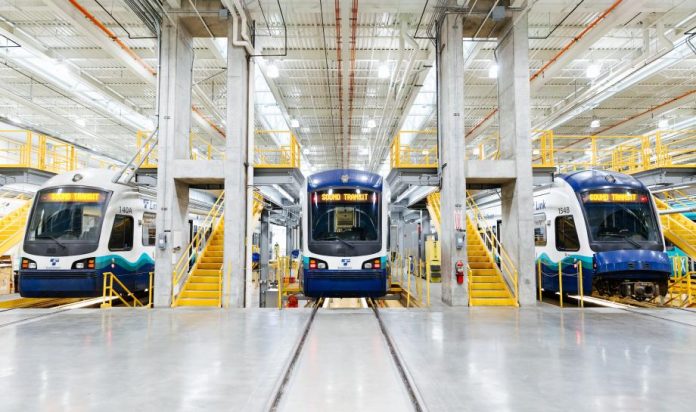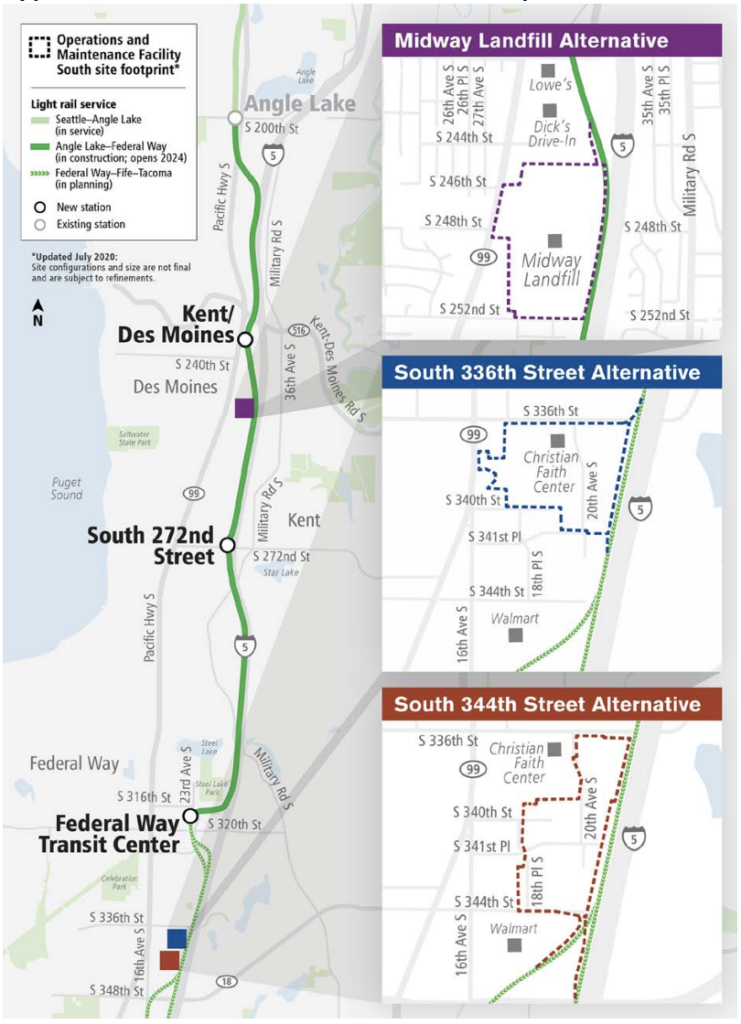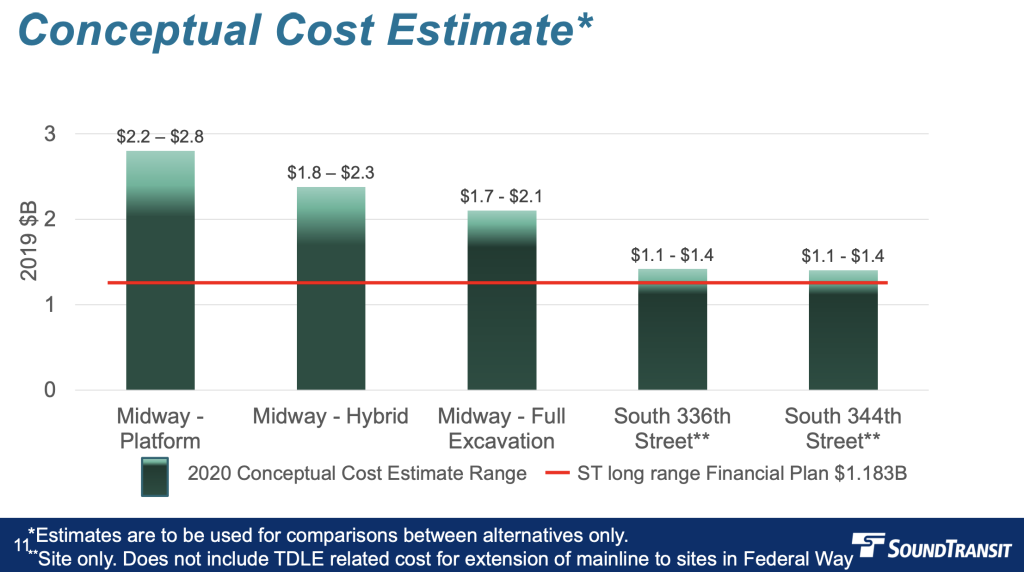Boardmembers face a tough choice that could impact when the Tacoma Dome and West Seattle Link Extension open.
The Sound Transit board of directors have a big decision to make on siting a new operations and maintenance facility. Today, the board’s System Expansion Committee is set to recommend a preferred location, as part of a state- and federally-mandated environment review process, to the agency’s board. Three locations in South King County have been shortlisted. Whichever one is chosen as the preferred location is likely to be the ultimate development site for an 60-acre-or-more light rail storage, maintenance, and operations facility employing about 470 people.
The three shortlisted Operations and Maintenance Facility South (OMFS) locations present unusually complicated competing factors that are likely to challenge boardmembers’ political instincts. On the one hand, the board could choose the site in Kent, which sits upon a former active landfill site and presents a multitude of challenges to development and timing and financial risks. On the other hand, the board could choose one of two sites in Federal Way, which would require displacing civic institutions and residents and introduce permitting obstacles.
A closer look at the sites
So to understand why the choice to pick a location is challenging, it’s worth digging into how each of the shortlisted locations compare in broad strokes:
- The Kent site is situated upon a geologically-unstable and environmentally-fraught Superfund brownfield that was previously used as the Midway Landfill. That’s made the site unattractive to development for decades, but its large size (68 acres) could be a boon to a sprawling operations and maintenance facility. Sound Transit has outlined three divergent options for developing the site using either the platform, hybrid, or full excavation approaches. Each option presents considerable risk and costs to the overall Sound Transit 3 program. Project delivery could be delayed by at least two-and-a-half to five years for the facility and have downstream impacts on the Tacoma Dome and West Seattle Link Extension openings. Conceptual cost estimates also suggest that project costs could range $1.7 billion to $2.2 billion, depending upon option, which are vastly higher than than the Federal Way alternatives and well out of Sound Transit 3 program affordability (by $600 million to $1.1 billion) set out in this past summer’s program realignment.
- The Federal Way S 336th Street site abuts I-5 and the future Tacoma Dome Link Extension stretching to SR-99 and from S 336th Street to about S 341st Place. The site could span about 59 acres and would require displacing some businesses (two businesses and 94 jobs), single-family residences (14 homes), and a religious institution (one church). It would also impact some local environmental features. Overall, the displacement impacts are less than the other Federal Way option, but the environment impacts are a little higher for wetlands (3.5 acres), forested areas (15 acres), and streams (1,400 linear feet).
- The Federal Way S 344th Street site also abuts I-5 and the future light rail extension, but it would stretch less westward and instead stretch further south to S 344th Street. The site would also be larger at about 65 acres. Compared to the other Federal Way option, this one would require displacing a larger number of businesses (11 businesses and 214 jobs), single-family residences (20 homes), and cultural and religious institutions (three institutions). But it would have a slightly smaller impact on environmental features like wetlands (1.5 acres), forested areas (12 acres), and streams (1,200 linear feet).
Both Federal Way options would require that Sound Transit obtain street vacations to proceed with site development and code deviations. That would put additional power in the hands of Federal Way, but the agency assumes that it would be able to obtain these approvals. Additionally, Sound Transit has conducted a federally-required equity analysis on all of the site option and did not identify any disparate impacts on communities of color because of a project.
Tough choices ahead for decision-makers
A final decision on a preferred location won’t be made until the Sound Transit board’s December 16th meeting, but today’s recommendation will be an important statement and could weigh heavily on decision-making by the full board next week. The board will ultimately need to pick a preferred alternative to be studied as part of Final Environmental Impact Statement next year, which could be issued toward the middle or end of 2022. That would allow the board to then proceed to selecting a project to be built, paving the way for project design and construction in the years ahead (2023 to 2029). The facility could ultimately open in 2029 prior to the planned Tacoma Dome and West Seattle light rail extensions in 2032.
Nevertheless, each site presents issues that could make favoring one over the others an unpopular choice. Yet, there are critical considerations that boardmembers will need to keep in mind in advancing a preferred alternative: security of the overall Sound Transit 3 program by keeping the project on schedule and within an affordable cost window. In that vein, it’s abundantly clear that the Kent site should be eliminated since it would risk delaying the entire Tacoma Dome and West Seattle Link Extensions and may force cutting back on the project’s quality. It would also betray promises to voters. That leaves the Federal Way locations as the best remaining choices. Weighing those is still no easy task given that residents, businesses, and institutions would be displaced in the process, but the S 336th Street location would displace the fewest.
Tough choices are part of a decision-maker’s jobs. But whether or not boardmembers make a prudent one will be tested today.
You can contact the board to share you opinions in advance of the meeting.
Stephen is a professional urban planner in Puget Sound with a passion for sustainable, livable, and diverse cities. He is especially interested in how policies, regulations, and programs can promote positive outcomes for communities. With stints in great cities like Bellingham and Cork, Stephen currently lives in Seattle. He primarily covers land use and transportation issues and has been with The Urbanist since 2014.




